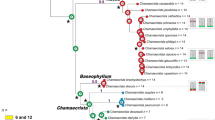Abstract
Chromosomal studies ofMedicago lesinsii (n = 8) and its close relativeM. murex (n = 7) have led to the competing hypotheses that the latter is derived directly from the former, or that both originated from a common ancestor. In contrast to the relatively variableM. murex, M. lesinsii proved to be almost uniform isozymically, except that most populations of Greece differed by one allele from plants of the remainder of the range. This Greek variant ofM. lesinsii was indistinguishable from one of the isozyme variants ofM. murex. The greater level of allozyme variation inM. murex was consistent with its greater ecological amplitude and competitive ability. Also, this suggests thatM. murex is unlikely to have originated directly from the less variableM. lesinsii. The data suggest that either both species originated from a common ancestor, or that the n = 8 species evolved from the n = 7 species, a mode of chromosome evolution not previously hypothesized for the genus.
Similar content being viewed by others
References
Abdelguerfi, A., Guittoneau, G.-G., 1989: Morphologie, écologie et répartition duMedicago heterocarpa Spach (=M. lesinsii Small) en Algérie, espèce méditerranéenne du complexeM. murex Willd. — Candollea44: 423–433.
Barrett, S. C. H., 1982: Genetic variation in weeds. — InCharudation, R., Walker, H. L., (Eds.): Biological control of weeds with plant pathogens, pp. 73–98. — New York: Wiley.
Crawford, D. J., Smith, E. B., 1982: Allozyme variation inCoreopsis nuecensoides andC. nuecensis (Compositae), a progenitor-derivative species pair. — Evolution36: 379–386.
—, 1985: Allozyme variation within and betweenLasthenia minor and its derivative speciesLasthenia maritima (Asteraceae). — Amer. J. Bot.72: 1177–1184.
Gillespie, D. J., 1987: Murex, a new medic for acid soils. — InWheeler, J. L., Pearson, C. J., Robards, G. E., (Eds.): Temperate pastures, their production, use and management, pp. 172–174. — Australia: Australian Wool Corporation/CSIRO.
—, 1988: Murex medic—a new pasture species. — J. Agric. W. Australia29: 132–138.
—, 1989: Registration ofMedicago murex cv. “Zodiac”. Register of Australian herbage plant cultivars. — Austral. J. Exp. Agric.29: 300–301.
Gottlieb, L. D., 1974: Genetic confirmation of the origin ofClarkia lingulata. — Evolution28: 244–250.
—, 1982: Conservation and duplication of isozymes in plants. — Science216: 373–380.
—, 1984: Electrophoretic analysis of the phylogeny of the self-pollinating populations ofClarkia xantiana. — Pl. Syst. Evol.147: 91–102.
Heyn, C. C., 1963: The annual species ofMedicago. — Jerusalem: Magnes Press, The Hebrew University.
—, 1981:Trifolieae (Bronn)Benth. — InPolhill, R. M., Raven, P. H., (Eds.): Advances in legume systematics 1, pp. 383–385. — Kew: Royal Botanic Gardens.
Lesins, K. A., Lesins, I., 1979: GenusMedicago (Leguminosae), a taxogenetic study. — The Hague: W. Junk.
—, —, —, 1970:Medicago murex with 2n = 16 and 2n = 14 chromosome complements. — Chromosoma30: 109–122.
Mariani, A., Falistocco, E., 1990: Chromosome studies in 2n = 14 and 2n = 16 types ofMedicago murex. — Genome33: 159–163.
Nei, M., 1972: Genetic distance between populations. — Amer. Naturalist106: 283–292.
Raelson, J. V., Grant, W. F., 1988: Evaluation of hypotheses concerning the origin ofLotus corniculatus (Fabaceae) using isoenzyme data. — Theor. Appl. Genet.76: 267–276.
Rohlf, F. J., 1990: NTSYS-pc, numerical taxonomy and multivariate analysis system, version 1.50. — Setauket, New York: Exeter Software.
Small, E., Brookes, B., 1985:Medicago lesinsii, a new Mediterranean species. — Canad. J. Bot.63: 728–734.
Warwick, S. I., 1990: Allozyme and life history variation in five northwardly colonizing North American weed species. — Pl. Syst. Evol.169: 41–54.
Weeden, N. F., Wendel, I. F., 1990: Genetics of plant isozymes. — InSoltis, D. E., Soltis, P. S., (Eds.): Isozymes in plant biology, pp. 46–72. — Portland, Oregon: Dioscorides Press.
Author information
Authors and Affiliations
Rights and permissions
About this article
Cite this article
Small, E., Warwick, S.I. & Brookes, B. Isozyme variation and alleged progenitor-derivative relationships in theMedicago murex complex (Fabaceae). Pl Syst Evol 181, 33–43 (1992). https://doi.org/10.1007/BF00937585
Received:
Revised:
Accepted:
Issue Date:
DOI: https://doi.org/10.1007/BF00937585




